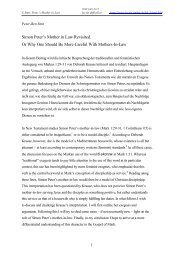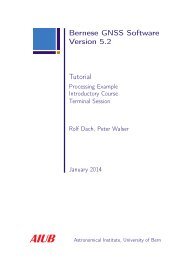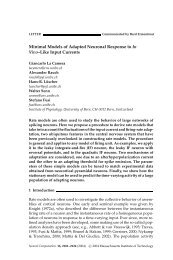The Light Field Camera: Extended Depth of Field, Aliasing, and ...
The Light Field Camera: Extended Depth of Field, Aliasing, and ...
The Light Field Camera: Extended Depth of Field, Aliasing, and ...
- No tags were found...
Create successful ePaper yourself
Turn your PDF publications into a flip-book with our unique Google optimized e-Paper software.
982 IEEE TRANSACTIONS ON PATTERN ANALYSIS AND MACHINE INTELLIGENCE, VOL. 34, NO. 5, MAY 2012TABLE 1Average L 2 Norm Disparity Error (Pixels per View 10 3 ),against Noise Levels, Filtering Method: No (A), Ideal (B),<strong>and</strong> Iterative Filtering (C), 4 textures <strong>and</strong> at 2 scales:Fine (1), Coarse (2)Fig. 12. Synthetic data: antialiasing filtering. Top: LF image <strong>of</strong> a sum-<strong>of</strong>two-sinusoidstexture (at five depth planes). Bottom: (a) One extractedview, containing aliasing. (b) <strong>The</strong> view filtered with the estimated depth(left) <strong>and</strong> the corresponding high-frequency image (right). (c) As in (b),but using the true depth; there is little difference between the two.(d)-(f) Enlarged portions <strong>of</strong> the last depth step in (a)-(c).by the convexity <strong>of</strong> the cost functional. <strong>The</strong> total runtime pertile is typically 30-60 seconds, depending on depth.8 EXPERIMENTS<strong>The</strong> antialiased 3D depth estimation method is tested on bothsynthetic <strong>and</strong> real data in Section 8.1. <strong>The</strong>n, the proposed SRmethod is tested similarly in Section 8.2. We also evaluaterestoration performance in Section 8.2.2, comparing to othercomputational <strong>and</strong> regular camera systems.8.1 Antialiased <strong>Depth</strong> Estimation8.1.1 Synthetic Data<strong>The</strong> scene in Fig. 12 consists <strong>of</strong> five steps at different depths,with a texture that is the sum <strong>of</strong> sinusoids at 0.2 <strong>and</strong> 1.2 timesthe views’ Nyquist rate f 0 , therefore the higher frequency isaliased in the views (but not in the subimages). <strong>The</strong> scene hasdisparities in the range s ¼ 0:24 to 0.44 pixels per view. Wesimulate a camera with Q ¼ 15, ¼ 9:05 10 6 m, d ¼0:135 mm, v ¼ 0:5 mm, f ¼ 0:5 mm, v 0 ¼ 91:5 mm, <strong>and</strong>F ¼ 80 mm. Note that for these settings, the microlens bluris small but nonnegligible, varying between 1.2 <strong>and</strong> 2.1 pixelsradius. We use the 9 9 pixel central region <strong>of</strong> each subimagefor depth estimation. Fig. 12 shows one <strong>of</strong> the 81 extractedviews, <strong>and</strong> the result <strong>of</strong> filtering with the estimated <strong>and</strong> truedisparity maps, with the aliased component separated out. InFig. 13, we compare the resulting disparity maps recoveredwith no antialiasing filtering, the iterative method, with thecorrect antialiasing filter (the errors at depth transitions occurdue to lack <strong>of</strong> occlusion modeling in the synthesized data),<strong>and</strong> the ground truth.We also test the algorithm’s performance, repeating theexperiment at 16 depths (for s ¼ 0:1 to 0.6). Results in Table 1show the average L 2 norm per pixel <strong>of</strong> the error between theRow header is in the format (Texture/Scale).ground truth <strong>and</strong> the disparity maps obtained with differentfiltering. We use the sinusoidal pattern <strong>and</strong> three texturestaken from the Brodatz data set (http://sipi.usc.edu/database/database.cgi?volume=textures). Each texture isresized to 380 380 pixels, <strong>and</strong> tested again with the central50 percent enlarged to this size to give a coarser scale. Wetest both the noise-free case <strong>and</strong> with additive Gaussianobservation noise at two different levels. <strong>The</strong> texturescontain different proportions <strong>of</strong> high <strong>and</strong> low frequencies;when more high frequencies are removed due to aliasing,matching performance decreases as less texture contentremains to match.8.1.2 Real Data<strong>The</strong> use <strong>of</strong> small f=10 microlens apertures <strong>and</strong> a largemicrolens spacing (27 pixels per subimage) results insignificant aliasing in the data from Georgiev <strong>and</strong>Lumsdaine [22] (kindly made available by Georgiev athttp://www.tgeorgiev.net), hence it is a good test for theantialiasing algorithm. Other camera settings are asdescribed in [6], [22]. Subimages <strong>and</strong> view details <strong>of</strong> thisdata are shown in Fig. 10, for different filters, toappreciate the effect <strong>of</strong> an incorrect size. In Fig. 14, weshow the disparity maps obtained at different steps <strong>of</strong> theiterative algorithm (the first iteration is essentially ast<strong>and</strong>ard multiview stereo result), along with the finalregularised result. Notice that there is a progressivereduction in the number <strong>of</strong> artifacts <strong>and</strong> that the disparitymap becomes more <strong>and</strong> more accurate. <strong>The</strong> estimatedFig. 13. <strong>Depth</strong> estimates. From top to bottom: Results obtained withoutfiltering, with the iterative method, with the correct filtering, <strong>and</strong> theground truth. Each row shows the disparity map (a) without <strong>and</strong> (b) withregularization. Notice how the results obtained with the estimated depthare extremely similar to those obtained with the correct filter.Fig. 14. <strong>Depth</strong> estimates on real data. (a) Disparity map estimateobtained without regularization (left) <strong>and</strong> for increasing filtering iterations(middle <strong>and</strong> right). (b) L 1 regularized disparity map, from the energy <strong>of</strong>the third iteration. (c) Regularized depth map for the puppets data set(Fig. 18).
















